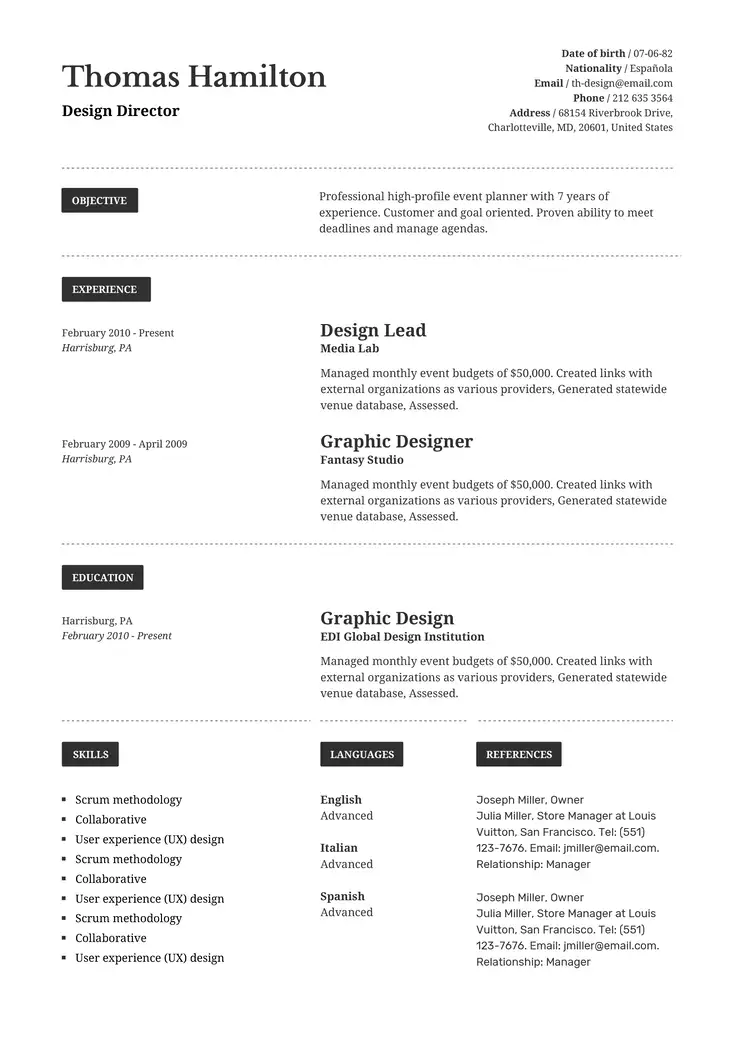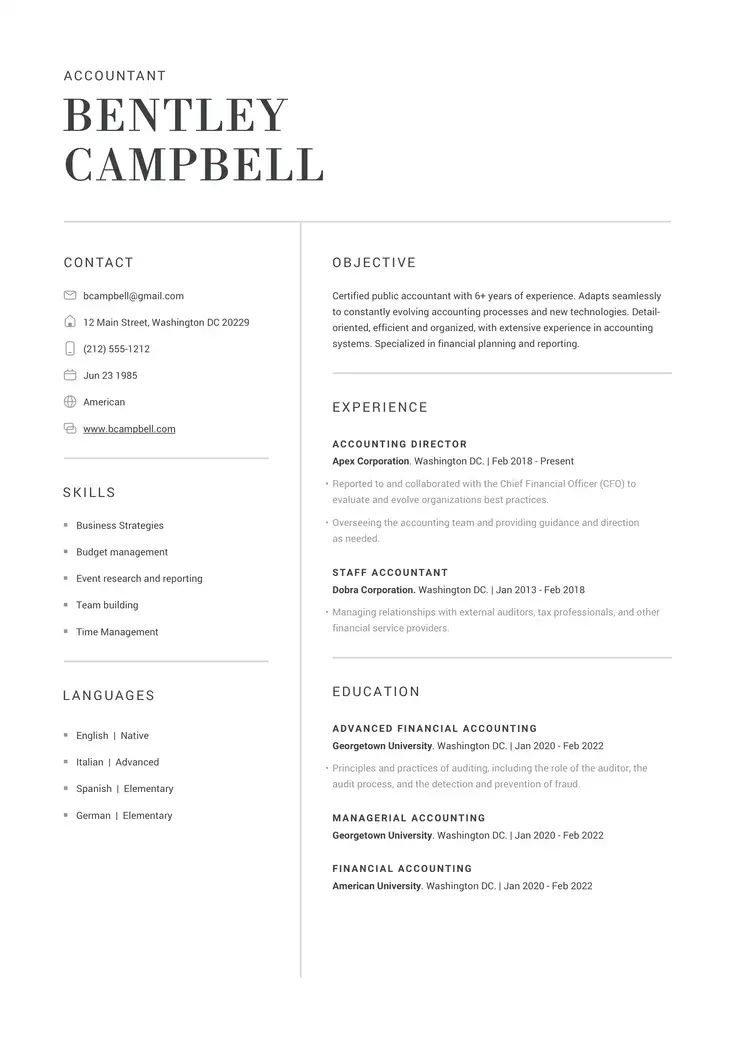How To Put an Internship on Your Resume: Examples and Tips
Showcase your knowledge and experience in the industry.

If you’re a student, recent graduate, or entry-level applicant, you might despair over your “empty” resume.
The good news is that you likely have more experience than you think. Your internship experience is just as valuable and relevant as any other work experience. That’s true whether it was a paid or unpaid internship.
Below, you’ll learn how to draft an internship resume as a student or incorporate internship experience on your resume, especially if you lack other experience.
For additional help, try our AI resume builder to get instant suggestions on internship entries.
How To Write a Resume for an Internship
You’ll likely need to submit your resume when applying for your first internship. The key is to include whatever skills and experiences you can that are relevant to the internship you’re applying for.
Use an “Experience” heading, list the organization, location, and dates, and show what you accomplished in the bullet point descriptions. These might include:
- Summer jobs
- Volunteer work
- Sports
- Responsible roles at your school or university
- Personal projects
Then, create a “Skills” section and list the skills you’ve gained through these experiences.
💡Tip
Our AI skills generator can give you instant suggestions of the best skills to include based on your industry.
Finally, write a summary for the top of your resume, summing up what you bring to the table and want to accomplish through the internship.
When To Put an Internship on Your Resume
If an internship is relevant to a position you’re applying for, include it. If it demonstrates that you have the required skills and experience for a job, it will give you a big advantage. Forbes reports that interns may be 25 percent more likely to receive job offers than non-interns.
If you have recently graduated or are still in college, you probably don’t have much relevant work experience. In this case, your internships should appear prominently on your student resume.
Similarly, if you are changing careers and need to write an entry-level resume for a new industry, internships can help you get the break you need, and they should be one of the focal points on your resume.
When not to include internships on your resume
Although internships can play a crucial role in advancing your career, however, they are not as valuable as full-time jobs. If you have gained enough experience in paid positions, adding an internship to your resume may not be advantageous.
If you have more than one or two positions in an industry, you shouldn’t keep the internship on your resume unless it is particularly impressive. For example, you might retain internship with major players like Apple, Google, or the White House on your well-developed, mid-career resume.
How To Write About an Internship in Your Resume
Including an internship on your resume is basically the same as adding job descriptions. In fact, you can list your internship under your work experience or make a separate section for internships. Here’s how.
- List the job title, company name, and dates you were there.
- Write a description of your responsibilities.
- Highlight potential resume keywords in the description of each position.
- Include keywords from the job description in your bulleted responsibilities.
💡Tip
There’s no need for exact dates. You might include the month and year (e.g., “June 2016” or “May-September 2016” or the season (“Summer 2017”).
It’s a good habit to make a list of every responsibility you had during your internship. This will enable you to add or delete the responsibilities depending on their relevance (or irrelevance) to the job. This approach will widen your appeal from the perspective of employers, making you a stronger candidate for a broader range of jobs.
When you tailor your resume, trim down the list to focus on the most impressive, most relevant aspects of your internship position. Even if you spent most of the time making photocopies or fetching coffee, only include the parts of the internship that are relevant to the position you’re applying for.
Where should your internship entries appear on your resume?
A common mistake is to put an internship at the bottom of the resume. In the absence of enough relevant experience, it should appear prominently.
If your internships are more relevant to the position you’re applying for than your paid work experience, put them at the top of your resume. If you have a more impressive recent paid position, put your internships below your work experience.
Once you’ve completed your resume, take a moment to use a resume checker tool to grade your resume and highlight any improvements.
How To Put an Incoming Internship on a Resume
Just as you include your prospective degree and potential graduation date in your education section, you can leverage internships you expect to start. How?
In your “Experience” or “Internships” entry, include the term “Expected” or “Anticipated” before the dates. Your descriptive bullet points can be future-focused, describing the experiences and skills you expect to gain. You can base these on the internship’s description.
Your entry might look something like this:
Marketing Intern (Expected May 2026 – August 2026)
ABC Creative Agency – Boston, MA
Selected for a competitive summer internship focusing on digital marketing and brand strategy to assist with campaign development, social media analytics, and client research.
Internship on a student resume example
Internships are a very important part of your student resume. You may not have had a full-time job yet, but you can include your internship alongside any part-time or summer jobs. Consider the following example.
Experience
Web Design Intern (May 2025 – August 2025)
PixelPoint Creative – Boston, MA
- Designed and updated responsive websites for small business clients using HTML, CSS, and WordPress.
- Collaborated with senior designers to improve site navigation and user experience based on client feedback.
- Optimized images, layouts, and page load times, contributing to a 20% increase in client satisfaction scores.
Sales Associate Intern (May 2024 – August 2024)
TechTown Electronics – Portsmouth, NH
- Assisted customers in selecting computer equipment and software for personal and professional use.
- Demonstrated website builder tools and provided basic troubleshooting support.
Example of an internship on a career change resume
Internships can help smooth a transition between industries at any point in your career. The internship can help you gain experience for the new role you seek.
In this case, the internship should overshadow less relevant work experience, while highlighting transferable skills.
Consider this example of a high school teacher transitioning into web design.
Experience
Web Design Intern (January 2025 – June 2025)
BluePixel Creative Agency – Austin, TX
- Completed an intensive internship focused on UX/UI design, front-end development, and responsive web layouts.
- Designed landing pages and interactive elements using HTML, CSS, and JavaScript; conducted user testing to improve accessibility and ease of navigation across devices.
- Drew on communication and organization skills from prior teaching experience to manage multiple design projects effectively.
High School English Teacher (2015 – 2024)
Jefferson County School District – Denver, CO
- Developed engaging digital learning materials and managed classroom technology tools.
- Led after-school workshops introducing students to basic coding and website creation.
- Coordinated cross-department projects, strengthening teamwork and presentation abilities.
Frequently Asked Questions (FAQs)
Yes, employment history can include internships, but it doesn’t have to. Internships can provide evidence of professional experience and skills, whether they were paid or unpaid. They can also bridge career gaps.
However, you may choose not to include them if they are not relevant to the position you’re applying for or took place more than 10 years or two jobs ago. Alternatively, you might choose to list internships in their own section, separate from your employment.
If you need to write a resume for an internship with no experience, think about anything you’ve done that may provide evidence of transferable skills.
Think about including the following categories of experience:
- Academic projects or recognition
- Sports teams
- School organizations, clubs, or extracurricular activities
- Leadership roles
- Volunteer service
- Personal projects or hobbies
You can create a general “Experience” section for a variety of experience types, or you can create dedicated sections like “Volunteering” or “Awards and Honors.” You might even choose to list some of these experiences under your Education section.
Typically, you can use the reverse chronological resume format. In this format, you’ll list your most recent experience first, and work your way backwards.
What, though, if your internship is extremely relevant but it’s not the most recent? You may choose to use a hybrid or functional resume format to get your internship to the top of the page.
These resumes allow for more flexibility, giving the most important information priority regardless of the dates involved.

